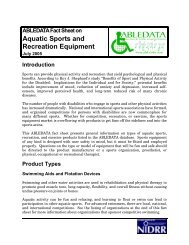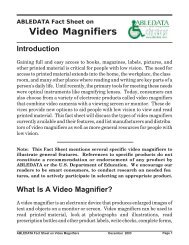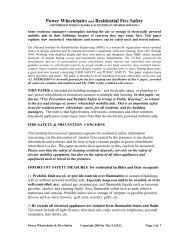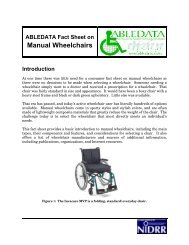Power Wheelchairs and User Safety - AbleData
Power Wheelchairs and User Safety - AbleData
Power Wheelchairs and User Safety - AbleData
Create successful ePaper yourself
Turn your PDF publications into a flip-book with our unique Google optimized e-Paper software.
with Cerebral Palsy, some with Multiple Sclerosis, some with Parkinson Disease,<br />
<strong>and</strong> people with many other conditions. Some of these conditions may cause<br />
impaired eyesight, slowed reflexes <strong>and</strong>/or impaired judgment. All should be fully<br />
screened for such functional deficits just as for automobile driving safety.<br />
MODERATE RISK.<br />
D) People with Little or No Upper Body Movement, using special quad controls<br />
such as mouth joystick, puff & sip breath control, or gyroscopic (inertial)<br />
wheelchair controls. HIGH RISK.<br />
E) Paralyzed Small People – Children <strong>and</strong> “very small” Adults ...in special seats<br />
or carriers often need a power wheelchair, most of all when significantly<br />
paralyzed. Depending on mechanical implementations, individual conditions, <strong>and</strong><br />
personalized mobility <strong>and</strong> safety training, these people are at HIGH RISK.<br />
SAFETY - INFORMATION ... for <strong>User</strong>s of <strong>Power</strong> <strong>Wheelchairs</strong><br />
1) Mechanical BRAKES that can be set or released by the wheelchair user<br />
are necessary safety items – an absolute “must” for outdoor wheelchair<br />
use. Some chairs have mechanical brakes that are h<strong>and</strong>-operated by a user<br />
with normal functioning of both h<strong>and</strong>s - but not by users with impaired<br />
h<strong>and</strong>s. Other chairs have no mechanical brakes but use “dynamic<br />
braking.” This helps slow the chair to a rapid stop when powered <strong>and</strong><br />
moving. It does NOT lock the wheels to prevent rolling down a steep incline.<br />
Buyers of power wheelchairs should always insist that the vendor includes<br />
mechanical brakes that the user can operate. They must be operable when<br />
moving, to brake, stop <strong>and</strong> lock the chair. And it must be possible for the<br />
wheelchair user to manually lock or to release the mechanical brakes ...<br />
when stopped. For quadriplegics unable to move a lever, it is feasible to<br />
use st<strong>and</strong>ard mechanical brakes that are set, locked <strong>and</strong> unlocked by small<br />
user-controllable electric motors.<br />
2) FRONT-WHEEL Configurations are very important for user safety.<br />
<strong>Power</strong> wheelchairs for outdoor use should always have powered large<br />
wheels in front; never free-swinging casters. Indoor wheelchairs with front<br />
casters are safe for outdoor use only on flat, level surfaces. They are at<br />
risk on sidewalks because of slab variations <strong>and</strong> irregularities, <strong>and</strong> totally<br />
unsafe on grass <strong>and</strong> soil. <strong>Wheelchairs</strong> with front casters are designed for<br />
indoor use because they offer better indoor maneuverability.<br />
3) USER ARM-STABILIZATION should be considered for the wheelchair<br />
user with impaired arm <strong>and</strong> h<strong>and</strong> function. An orthotic elbow or forearm<br />
support can be installed on the wheelchair to support the h<strong>and</strong> used to<br />
operate the wheelchair’s controls. This support can provide vital<br />
stabilization for the h<strong>and</strong> that steers <strong>and</strong> controls the power wheelchair.<br />
4) SAFETY SHUT-OFF & BRAKING CONTROLS should be provided<br />
for power wheelchair users who use mouth, breath, or other than h<strong>and</strong><br />
controls. The user with normal use of one h<strong>and</strong> can steer the power<br />
<strong>Power</strong> <strong>Wheelchairs</strong> & <strong>User</strong> <strong>Safety</strong> Copyright 2003 by The N.I.R.E. Page 5 of 8







